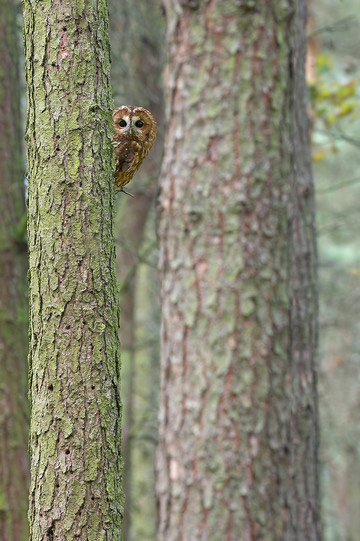
Tawny Owl © Ben Hall
Tawny Owls were found in winter in 278 tetrads, but the distribution is puzzling, comprising 193 tetrads with breeding season and winter records, 85 tetrads with a winter record but no breeding season presence, and 111 in the breeding season where it was not found in winter. They are long-lived birds and, after their first autumn, sedentary: an adult male, at least three years old when ringed at Norton Priory, Runcorn (SJ58L) in December 1996 was retrapped in the same place five years later, and a first-year male ringed at Woolston (SJ68P) in November 1990 was retrapped there in May 1996. Some of the ‘extra’ winter tetrad records may be first-year birds, prospecting for territories after they have been noisily driven out from their parents’ territory, usually by October or November: these inexperienced birds may well occupy unusual areas that are unsuitable for breeding, although they will try to breed at one year of age if they can attract a mate.
Nevertheless, the difference between winter and breeding distribution is a surprising result for a species that is normally reputed to be one of the most sedentary of all birds, with the adult birds normally remaining in their territories all their lives, all year round. This discrepancy was obvious even from the first year’s records, and observers’ attention was drawn to it in the December 2005 Atlas newsletter, with the exhortation to ‘please try to get out and visit your tetrad, listening for owls, during this winter, especially if they bred in the area: it only needs a few minutes on a clear night, and a bit of luck, to hear one, and you might pick up some other species as well. And, in those tetrads where the species was found in winter but not in the breeding season, they are likely to be breeding somewhere close, so please try to find where!’ After a further two years of fieldwork, however, the stark seasonal differences persist and it remains an open question whether this is a real feature of the species’ biology or a recording effect of observer bias.
All but eight of the submitted counts were of one or two birds, with five records of three and three counts of four birds, near Warmingham (SJ76B) in winter 2004/ 05 and 2005/ 06, and near Lower Peover (SJ77M) in the first winter. The habitat codes show most records from woodland (58%), but surprisingly high proportions in farmland (17%), with even more in human sites than during the breeding season (68 records, 22% of the total).
Adult Tawny Owls start reinforcing their territory at the beginning of winter, calling frequently. In courtship feeding, from December to February, the male brings extra food to his much larger mate to cement the pair-bond and to build up her condition for an early start to breeding. In some ways, winter might be an easier season for the species, with long nights for their feeding, although the reduced numbers of some prey species causes some owls to shift their diet to feed more on birds, and many roosts of thrushes and finches suffer frequent attention from a Tawny Owl or two.
In autumn 2005 the BTO organised a national survey of Tawny Owls, observers re-visiting tetrads covered in the earlier 1989 survey. Publication of the results is awaited.
Sponsored by John Patterson

